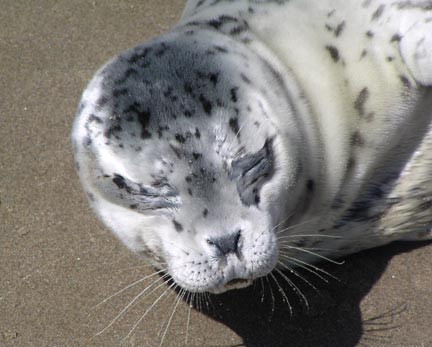Netarts Bay has it own year-round population of harbor seals, Phoca vitulina richardii, which you can often see at low tide, hauled out on the sand bar opposite the Netarts Bay R/V Park and Marina or just inside the end of Netarts Spit across from Happy Camp. These two favorite haul-out sites are adjacent to deep water, allowing a ready escape if the seals are disturbed. On the sand, they may lie prone and relaxed, or they may assume what is called the banana posture where they rest on their bellies with their heads and hind flippers raised in the air, looking much like large, gray bananas. They tolerate boaters who keep their distance, but if you approach them as they bask on the sand bars, even creeping up on them in a silent kayak, they raise their heads like sentinels and watch your every move, full of caution and curiosity, until at the critical distance, when nervousness evolves into the feeling of threat, they slide into the water where they feel safe. They will surround your boat, their heads poking out of the water, still reserved but interested, their big brown eyes wide with both wary and wonder. They are cumbersome on land, wiggling and scooting on their bellies, but in the water they are swift and agile, their torpedo-like bodies capable of underwater acrobatics. This sub species of harbor seal ranges from Cedros Island, a little more than a third of the way down the Baja California peninsula, to Alaska’s Aleutian and Pribilof Islands. They are not endangered; their total population surpasses 300,000. There are over 150 in Netarts Bay, perhaps as many as 200. They do not migrate but remain mostly in the bay, protected from predators such as killer whales, sharks, and steller sea lions, occasionally venturing into the ocean to roam, but not far from shore. They are opportunistic feeders, eating fish, crustaceans, including Dungeness crabs, squid, and mollusks. They generally swallow their food whole.
Their color is generally gray-brown with an arrangement of darker spots and rings unique on each individual. Their pelage, or fur, consists of coarse guard hairs underlain with dense, fine under hairs, which they molt annually. During the summer you may see some seals with a growth of green alga on their backs. Insulation is not provided by their coat but by a layer of blubber, which has blood vessels that constrict in cold water to conserve heat and dilate when they haul out to release heat. Their eyesight is good, especially underwater, but they do not perceive color. On land, they continually secrete mucous that coats and protects the eyes and drips down the sides of their faces, giving them a rather tearful, sorrowful look.
Males are slightly larger than females but otherwise similar in appearance, and both live to around thirty years. They court underwater, and when the female is pregnant, she gestates nine or ten months, often after a delayed implantation, giving birth to a single thirty pound-or-so pup, rarely twins, in May or June. A pup can crawl and swim soon after birth and is weaned after about four weeks. People sometimes see what appears to be a pup either stranded or abandoned on shore like the newborn pictured here on the beach near Oceanside in May of 2005 (the umbilical cord was still attached). Pups such as these are usually left by their mothers who are out hunting food. A mother will soon return, so do not touch or bother a pup. It is unlawful to disturb, handle or feed marine mammals.
How do you tell a seal from a sea lion? The easiest way is to look at the head. A seal has no ear flaps, just an external opening on each side. Sea lions have ear flaps.
Text and photographs by Jim Young
Oceanside, Oregon


